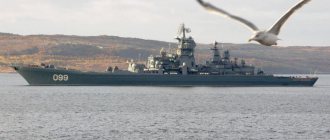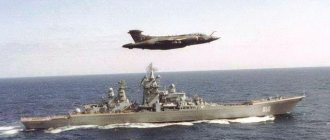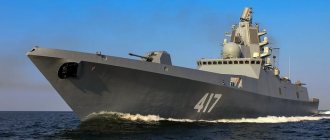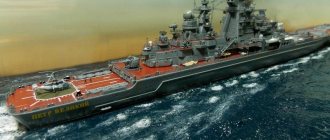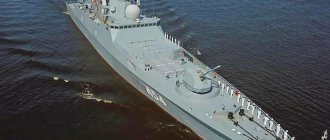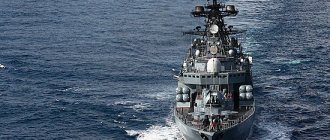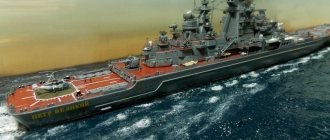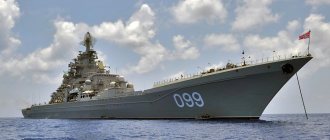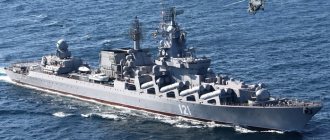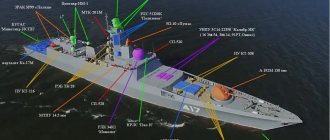Admiral Nakhimov is the name of a heavy nuclear-powered missile cruiser that entered combat service in the Northern Fleet of the USSR Navy in 1988. It did not have time to be noted for any special merits; a decade later it was put under repair with large-scale modernization. This process includes the use of the most modern technologies adopted in modern shipbuilding.
It remains under repair even now; the details, for obvious reasons, are not well covered. It is unknown whether the Admiral will become the flagship of the Russian fleet after this, but there is no doubt that it will be one of the best ships of this type.
The first "Admiral Nakhimov" - counting down the "unfortunate" ships
Few people know, but the current nuclear cruiser is already the seventh ship in the history of the Russian fleet, bearing the name of the famous naval commander. All his predecessors suffered a sad fate, as if some kind of fate haunts ships with this name. Sailors, a superstitious people, tend to see a mystical trace in this - supposedly, there were omnipresent otherworldly forces here. This explanation, of course, is far from scientific, but there is something inexplicable in the tragic fate of each “Nakhimov”.
The first of them was the armored cruiser (frigate) Admiral Nakhimov, launched from the stocks of the Baltic Shipyard in 1885. The ship was designed by the brilliant military shipbuilder engineer-Colonel Samoilov, who achieved amazing results.
Thanks to his efforts, the cruiser was the most modern and spectacular warship at the time of its launch. She became the first of the ships of the Russian Imperial Navy to be equipped with weapon turrets; deck artillery played a secondary role and became a thing of the past.
| Length, m | 101,3 |
| Width, m | 18,6 |
| Draft, m | 8,3 |
| Displacement, tons | 8473 |
| Power, l. With. -average -ultimate | 4000 7768 |
| Maximum speed, knots | 16,7 |
| Armor protection, mm sides of deck house barbettes | 254 203 152 51-76 |
| Main naval artillery | 4x2 x 203 mm 10 x 152 mm |
| Additional weapons | 12 x 47 mm 6 x 37 mm 2 x 64 mm |
| Torpedo tubes | 3 x 381 mm |
| Crew, man | 572 |
The ship's military history was not very long; the first and last war in which it took part was the Russian-Japanese war. But the armored cruiser Admiral Nakhimov was not lucky enough to show all its combat qualities in a serious collision. While passing the Korean Strait, the Russian squadron was attacked by the Japanese fleet, the cruiser received 30 holes and began to draw water.
Near the island of Tsushima, it was torpedoed by Japanese destroyers, receiving a hole in the bow on the starboard side. On the morning of May 15 (28), 1905, when enemy ships appeared, it was scuttled by its crew.
↑ Ship's armament
At the time of its creation, "Admiral Nakhimov" had very impressive weapons, which, when used, could cause devastating damage to the fleet of almost any enemy. "Nakhimov" has:
- Artillery - AK-120;
- Anti-aircraft installations - “Dirk” (six pieces);
- Powerful missile weapons - “Granit”, “Fort”, “Osa-M”;
- Powerful anti-submarine weapon system – RBU-12000, RBU-1000;
- Mine and torpedo weapons - PLUR "Waterfall", as well as a small aviation group Ka-27.
The tragic history of ships bearing the name of the famous admiral
“Admiral Nakhimov” was not the first, and far from the last of the ships of the same name, which were literally plagued by misfortune. Many people associate these events with the name, attribute some secrets and try to find a pattern in this. But nothing like this can be traced in the history of all the “Admirals”; everything that unites them is limited only by name.
As for the destruction of ships, there is nothing mystical in it, it seems natural, although not everything is so simple, some moments simply cannot be explained.
The first, whose death subsequently gave rise to talk about a fatal pattern, was the merchant steamer Admiral Nakhimov, which in 1897 made a regular voyage to Constantinople. She was caught in a storm near the Bosphorus, and sank with a cargo of grain and the entire crew.
The next of the “unlucky ships” was the cruiser of the Black Sea Fleet “Chervona Ukraine”, which before the October Revolution was called “Admiral Nakhimov”. In November 1941, after a massive raid by enemy aircraft, while at the entrance to Tsemes Bay, it received numerous damage, and sank a few hours later.
The only one of the Nakhimovs that did not sink, but ended its days quite peacefully, was a Soviet cruiser built shortly after the war. In 1960, it was decommissioned and for some time used as a target when testing new anti-ship missiles, as a result of which it received serious damage - the bottom of the cruiser was so deformed that it could not be repaired.
For some time, secrecy was maintained around him, as a result of which many people's imagination ran wild. But again, it is difficult to draw parallels between it and the armored cruiser Admiral Nakhimov, which sank off the island of Tsushima.
But in the death of the fifth and sixth “Admirals Nakhimovs,” there really is something mysterious and unnatural. First, misfortune befell a research vessel that unexpectedly sank in 1973, sinking like a stone in front of numerous witnesses, just minutes after capsizing.
This happened in the notorious fatal bay, literally at the very pier of Novorossiysk, and half of the crew drowned along with the ship. The most tragic was the fate of the last of the sunken ships with the name of the great naval commander. Its history has no connection with the armored cruiser Admiral Nakhimov, but, strangely, the Tsemes Bay again became the site of the crash.
On the last day of August 1986, the cruise ship Admiral Nakhimov, in good visibility, collided with the bulk carrier Pyotr Vasev at Cape Doob, 13 km from the port of Novorossiysk.
At 23:20, just 8 minutes after it is not clear how the collision happened, the ship completely disappeared under water. This was a real disaster that plunged the entire Soviet people into shock - out of almost 1,000 passengers and crew members, 423 people died or went missing, including almost 100 children.
“All factors were against passengers”
The captain of the Peter Vasev, Viktor Tkachenko, was transporting barley from the Canadian city of Be-Comeau and was in a hurry to quickly enter the port. He steered the ship at a speed of 12.5 knots. At 21:30 he climbed onto the bridge and took control. Next to him was third assistant Peter Zubyuk.
When the Admiral Nakhimov left the port, Tkachenko confirmed that he would let the ship through, both to the dispatcher and to Alexander Chudnovsky, but did not do so.
Tkachenko was driving the cargo ship, observing the situation with the help of ARPA, although, according to all the rules, he was obliged to conduct visual observation using binoculars. At the same time, the passenger ship, illuminated by bright lights, was perfectly visible to him. When we asked him why he didn’t give way, Tkachenko answered: “I thought I’d get through.”
Boris Uvarovinvestigator
According to colleagues who later testified, Tkachenko was a professional in his field. He was good at his craft and had awards for his services. But the captain of the cargo ship was distinguished by his love for extravagant actions: he loved dangerous and at the same time precise maneuvers, from which his colleagues were sometimes horrified.
After Chudnovsky’s first call, Zubyuk also requested a bearing and informed Tkachenko that a dangerous approach was taking place. The same one, looking at the screen, stated that everything was going according to plan and asked not to pull it. But Zubyuk again repeated that the bearing did not change.
But Tkachenko again did not listen, saying that the equipment showed that a “beautiful divergence” was about to occur.
Later, the examination will establish that ARPA transmitted data late. Tkachenko realized that there was trouble only after another panicked call from the ship.
Divers of the rescue ship "Amethyst" before diving to search for those missing after the sinking of the ship "Admiral Nakhimov". September 7, 1986
Photo: Vladimir Velengurin / TASS
He ordered the speed to be reduced, then he ordered a full reverse, but it was too late: the ship continued to move forward by inertia. A belated maneuver to the right did not help: the cargo ship rammed the side of the Admiral Nakhimov at full speed. Tkachenko quickly launched a rescue operation.
His men rescued 37 people from the water, but the next day the captain of the Petra Vasev realized that he was in trouble and stole the ship's log from his assistant Zubyuk
He drove it manually, as expected, and entered into it everything that happened to the cargo ship. As Boris Uvarov recalls, Tkachenko later told investigators that he had erased the records for that night and asked Zubyuk to enter other data. To the sailor’s credit, he refused, and later, using a pencil imprint on paper, he restored every word for the investigation.
The tragedy would not have happened if at least one of the three factors had worked. Tkachenko would have missed the ship, Markov would have remained at his job, and Chudnovsky would not have changed course. That night, all three factors were against the passengers of the Admiral Nakhimov.
Boris Uvarovinvestigator
The last of the “Admirals”: a new word in shipbuilding
The nuclear cruiser Project 1144 Orlan “Admiral Nakhimov” (TARKr) is one of 4 battleships of this type. It was launched from the stocks on April 29, 1986, 4 months before the disaster of the cruise ship of the same name, and two years later it entered service with the Northern Fleet. True, it was called “Kalinin” back then; it was renamed after the collapse of the USSR, in 1992. The track record of the new “Admiral” consists of several participation in tactical exercises with shooting in the waters of the Barents and White Seas.
According to the results, the cruiser performed well, and although overall Project 1144 was considered a failure, Admiral Nakhimov was the only one of its kind that lived up to expectations. First of all, “Admiral Nakhimov”, then still “Kalinin”, after launching, went to the Baltic, where it underwent 2-month testing of its running capabilities. The technicians were satisfied with all the indicators, after which the cruiser went to the North Sea, where more difficult conditions were created at the final stage of testing.
In total, during this time it covered more than 5,000 nautical miles, and no problems were found in the operation of the engines or navigation system. The new missile cruiser was considered quite fit for service, and at the end of 1988 it joined the 120th Brigade, which was part of the Red Banner Northern Fleet, where it became the most powerful of its ships.
After training firing using the main missile system, conducted in 1989 in the Barents Sea, the future “Admiral Nakhimov” deservedly received an award from the Commander-in-Chief of the USSR Navy. A year later, in 1990, she again distinguished herself during shooting in the waters of the White Sea, and was recognized as the best combat vessel of the 7th operational squadron of the Northern Fleet.
At the beginning of 1991, the already honored and recognized by the command missile cruiser, included in the tactical group consisting of 4 ships under the command of Alexander Brazhnik, went on its first combat duty to the Mediterranean Sea.
Here the cruiser was at the center of events, at the moment of rescuing the crew from the sinking Turkish ship Sveroglu. Its mission lasted six months, after which the heavy cruiser returned to Severomorsk at the end of July 1991.
“They get used to the ship and love it like a child.” About how the “Ash” and “Borey” are built by the Russian Navy
TASS - about some unique technologies used in the construction of nuclear submarines, and about the capabilities of the country's largest shipyard
A bottle of champagne was broken on a giant hull, the crew sang the Russian Anthem, and a state-of-the-art submarine was taken out of the boathouse of Russia’s largest shipyard, Sevmash. On the slipway train, the boat will first be taken to the dock of the loading pool, and then released into its native environment. It will be weeks and months before the Yasen or Borei meet the White Sea - American satellites will certainly film their arrival. This never goes unnoticed.
"Admiral Nakhimov" in difficult years for the Russian fleet
With the collapse of the Soviet Union, difficult times came for the cruiser, then still named Kalinin, as well as the entire Russian Navy. At the very end of September, the 120th Red Banner Brigade, one of the most combat-ready in the Northern Fleet, was disbanded. From individual ships, the brigade created the 43rd missile-carrying division, and again the cruiser was luckier than many others that went for dismantling and disposal; it was accepted into the ranks of the newly formed tactical flotilla.
Six months later, in April 1992, the ship received its current name and became the object of close attention of foreign delegations from Finland and Italy, who visited the Admiral Nakhimov that same fall.
In mid-autumn 1994, the nuclear-powered cruiser took part in tactical exercises as part of the strike group of the 7th operational squadron, along with the destroyers Rostoropny and Bezuderzhny. The firing training was carried out with the direct participation of the commander of the 43rd missile-carrying division, Rear Admiral Lyakin, and under the leadership of Rear Admiral Dobroskochenko, who was on board the Admiral Nakhimov.
The exercises were carried out in extremely difficult conditions, which indicated their significance; especially for this purpose, a water area of 300 km was blocked. Like 4 years earlier, the cruiser showed the best result and deservedly received the award from the Commander-in-Chief of the Navy.
Once again, “Admiral Nakhimov” proved its uniqueness and worth.
Of the 11 training targets in the form of cruise missiles traveling along a low trajectory with a launch interval of 5 seconds, the heavy cruiser hit 7 of them. The missiles of the Fort and Osa-MA complexes were used for firing, 19 of which were fired within 70 seconds, only 4 warheads missed and fell into the sea.
For comparison, the destroyers from the task force, having spent much more ammunition, shot down only 2 targets. The results shown by the heavy cruiser became a turning point and an example to follow when equipping other warships of the Russian Navy.
The Fading Power of the Carrier Killer
Today, the missile cruiser of the Russian Navy remains the largest warship of its type in the whole world. Representatives of the NATO bloc could not help but notice its combat qualities, noting the striking force and power of the ship, with apt and capacious characteristics, calling the cruiser an “aircraft carrier killer.”
But in reality, the capabilities of Admiral Nakhimov are much wider than they think in the West. It is capable of hitting both surface and underwater targets equally effectively. Repel air attacks and make long journeys while remaining virtually invisible to radar.
For comparison, we can cite the famous missile cruisers put into service with the US Navy and a number of friendly countries, such as the Ticonderoga. And also, the most powerful of NATO ships, the now decommissioned missile cruiser Colbert. This is the closest analogue of Project 1144 Orlan, they are designed to perform the same functions:
| Name | TAKR "Admiral Nakhimov" | Ticonderoga-class guided missile cruiser | French Navy cruiser Colbert |
| Length, m | 251 | 172,8 | 180,5 |
| Width, m | 28,5 | 28,5 | 20,3 |
| Draft, m | 9,1 | 9,7 | 6,5 |
| Displacement: - standard - full, tons | 24300 26190 | — 9800 | 9085 11100 |
| Travel speed: - average - maximum, knots | 17 32 | — 32 | — 33 |
| Power, l. With. | 140000 | 80000 | 87000 |
| Hiking distance, miles | No limits | 6000 | 4000 |
| Artillery | 1 x 2 AK-130 | 2 x 1 AU Mk 45 127 mm | 2 x 1 100mm Model68 |
| Anti-aircraft weapons | 6 ZRAK "Dirk" | 2 x 6 Phalanx CIWS 20mm 2 x 1 Mark-38 25mm | 6 x 2 57 mm modele 1951 |
| Missile weapons | 20 anti-ship missiles P-700 “Granit” S-300 “Fort” air defense system “Osa-M” air defense system launcher | PKRP "Harpoon" UVP "Tomahawk" | 1 x 2 launchers of the air defense missile system "Masurka" |
| Anti-submarine weapons | 1 x 10 RBU-12000 2 x 6 RBU-1000 | — | — |
| Aviation support | 3 Ka-27 | 2 Bell AH-1Z Viper: | 1 helicopter |
| Crew, man | 727 | 387 | 560 |
It is quite obvious that the characteristics of the modern heavy and armored cruiser of the century before last, Admiral Nakhimov, cannot be compared. However, at the end of the last century, the command of the Northern Fleet of the Russian Navy recognized it as technically obsolete.
In terms of service life, it is much inferior to its predecessor; its combat journey turned out to be unusually short, only 9 years. He never managed to go on his coveted combat duty in the vastness of the North Atlantic strategic sector. Instead, in 1997, after a visit and blessing from the patriarch, the cruiser went on its last trip to date - to the docks of the Severodvinsk repair plant.
Project evaluation
Project 1144 cruisers were the first and last nuclear-powered surface missile carriers of the USSR Navy, the first large-displacement ships built after a long break, and the largest non-aircraft-carrying military ships built by any state after World War II. But with its undoubted advantages - powerful offensive weapons, high autonomy and long-range ship-based air defense systems used for the first time in Soviet practice, the ship, nevertheless, is difficult to consider completely successful.
The dimensions and cost of the Project 1144 missile cruiser are very large, while the strike functions are inferior to the cheaper Project 949 and 949A Antey missile submarines. The main function of the ship - launching missile attacks on an aircraft carrier strike group (ACG) of the US Navy - is feasible, in fact, only with a coordinated surprise attack (for example, in combination with a submarine attack on the same AUG of the US Navy). As a weapon for a possible retaliatory strike, the ship is significantly inferior to SSGNs of Project 949 and 949A due to greater visibility to the enemy and greater vulnerability.
The weak point of the basic design was its vulnerability to low-flying subsonic anti-ship missiles. Close-in air defense on the first three cruisers was represented only by the Osa-M air defense system, which had low fire performance, a relatively long reaction time and was unable to operate on targets below 25-60 meters. This was partially compensated by the large battery of the AK-630 AU, the effectiveness of which, however, was also not considered sufficient.
The unclear definition of the ship's role during the design forced the designers to equip the system with many different types of weapons, which made the ships multi-purpose, but complicated maintenance and created problems with determining the tactical and technical niche of the ship.
Repair of Admiral Nakhimov and general modernization of outdated systems
According to the initial plan, the modernized new generation nuclear missile cruiser Admiral Nakhimov was supposed to be launched by the end of this year. But delays associated with the high cost of the planned project prevented this from happening; it was frozen for more than a decade. From 1999 to 2012 it stood untouched at Sevmash in Severodvinsk for 12 years, the only thing they did was unload the spent nuclear fuel.
From 2011 to 2012 work was carried out to prepare the battleship for transformation, and only in 2013, after the final conclusion of the contract with the Military Ministry, the transition to the active phase of modernization began.
The complete dismantling of outdated electronics and technical equipment continued for 3 years. In parallel with this, repairmen were engaged in defect detection of the hull - the only thing that will remain from the old cruiser. At the end of 2014, the thoroughly unloaded Admiral Nakhimov was transferred to a dock with a loading pool, where the firing part of the work began at the beginning of 2015.
At the end of 2015 - beginning of 2016. completed the unloading of old equipment and defect detection work, moving on to the process of priming the updated structure. At the moment, active work is already underway on the installation of modern systems and technical complex.
The same fundamental changes, in addition to the technical part, will also affect the weapons; the cruiser will be completely re-equipped. The Kortik, Smerch and Fort complexes, developed 40 years ago, are hopelessly outdated and ineffective compared to modern NATO standards.
Instead of old Soviet weapons, it is planned to install 10 of the latest Kalibr and Oniks vertical missile launch systems on the Admiral Nakhimov.
Particularly noteworthy are the Zircon hypersonic missiles, which reach speeds of Mach 8 and destroy even small targets at a distance of more than 1000 km. But the main features of such weapons are the complete helplessness of air defense against them.
According to the new plan, announced by official representatives of Sevmash, the completion of modernization is scheduled for 2022. One can still imagine what it will be like, even taking into account the meager information about it. But what awaits the seventh “Admiral Nakhimov” in the future, and whether it will repeat the fate of its predecessors, one can only guess about this
White elephants of the fleet
The Project 1144 Orlan heavy nuclear-powered missile cruisers are one of the visible symbols of the USSR Navy and at the same time a good example of what comes out of long red tape when developing and refining technical projects. The first approaches to the projectile began at the turn of the 1950s and 1960s, the lead ship was laid down in 1973, and was delivered to the fleet only in December 1980.
From the idea of creating a large anti-submarine ship with a nuclear reactor and a displacement of 8 thousand tons, two branches first grew (a nuclear-powered anti-submarine cruiser and a nuclear-powered cruiser with anti-ship weapons), then they were combined. The resulting multi-purpose monster with a displacement of over 25 thousand tons, still characterized in the West as a battle cruiser, with all its undeniable combat capabilities, turned into a warehouse for new weapon systems and electronic weapons for the fleet - with a concomitant increase in the complexity and cost of construction.
The USSR was able to introduce only three ships of this type: the lead “Kirov” (1980), “Frunze” (1984) and “Kalinin” (1988). The unfinished Yuri Andropov was inherited by the Russian Federation, which handed it over to the fleet in 1998 under the name Peter the Great.
Cruiser_1
Heavy nuclear missile cruiser "Admiral Lazarev" and floating workshop PM 74 (from left to right)
Photo: TASS/Vladimir Sayapin
By this time, the remaining ships were renamed, respectively, “Admiral Ushakov” (in 2004 the name was taken away and what remained was a formally nameless ship with tail number 090 and the letters “Kirov” missing), “Admiral Lazarev” and “Admiral Nakhimov”.
The cruiser's armament was based on 20 inclined launch silos of the Granit anti-ship missile system (range up to 600 km). Anti-aircraft weapons included the long-range S-300F Fort air defense system and the Osa-M self-defense air defense system (on the first three ships). On the Petra, instead of the S-300F, they installed the S-300FM Fort-M, and instead of the Osa, they installed the more modern Kinzhal. On Kalinin and Petra, the 30-mm AK-630 assault rifles were replaced with six Kortik short-range anti-aircraft missile and artillery systems. The composition of anti-submarine weapons and electronic weapons changed from ship to ship.
